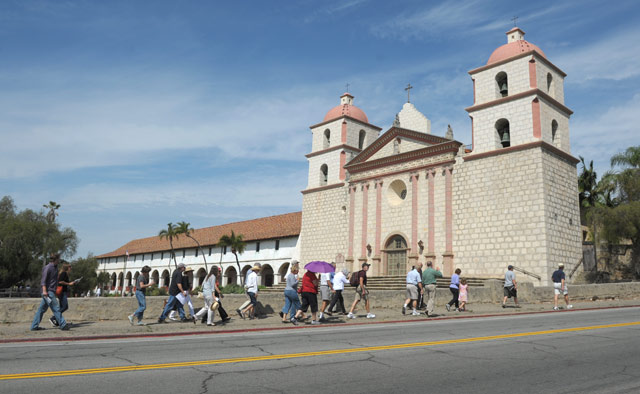Citizen Group Seeks Lower Mission Canyon Traffic Improvements
Coordinating With Government Officials and Area Stakeholders to Get the Ball Rolling

In the name of safety, history, and commerce, a cadre of residents and stakeholders is trying to kick-start the 65-year-old goal of uncorking the bottlenecked traffic of lower Mission Canyon, where a steady flow of cars, bicycles, and pedestrians converge between the Santa Barbara Museum of Natural History, Rocky Nook Park, and Old Mission Santa Barbara. Formed over a year ago, the 24-member Concerned Citizens for Safe Passage is reaching out to elected officials and government agency reps to form a unified, cooperative consensus on what improvements need to be made, who should spearhead which parts of the project, and how the work could be paid for.
On July 13, the group hosted a well-attended walking tour — City Councilmembers Cathy Murillo and Randy Rowse tagged along, while Mayor Helene Schneider and County Supervisor Salud Carbajal attended a similar tour last month — that traveled from Laguna Street and along East Los Olivos Street through the intersections with Alameda Padre Serra and Mountain Drive then onto Mission Canyon Road. While the area is steeped in history, the tour guides also pointed out that it’s replete with confusing signs and offers nearly no walkways for pedestrians. Bicyclists have a hard time navigating the narrow roads and blind turns, they noted, and tourists in their cars easily get lost and turned around.
Altogether, there’s an average of 10,700 daily trips on that stretch of Mission Canyon Road, with a peak of 1,000 in the evening rush hour. Add to that traffic tally nearly one million annual visitors to the Mission (not including those who attend religious services), more than 120,000 annual visitors to the Museum of Natural History, and approximately 14,000 people who annually attend events at the Santa Barbara Woman’s Club, Rockwood. During the school year, many students use the path to walk to and from nearby Roosevelt Elementary School and Garden Street Academy, explained architect Fred Sweeney of the Upper East Association, finally noting that the same route is supposed to accommodate thousands of foothill residents in the event of a wildfire.
“Living next door, I have actually witnessed several major accidents,” said Natural History Museum director Karl Hutterer in an email. “Fortunately, nobody was seriously injured in any of them, but it is only a matter of time.” Hutterer said the museum has offered the effort many hours of staff time, hosted meetings at the museum, and contributed financially to the costs of studies and printing a recent report. “The Mission, Rockwood Woman’s Club, and Suzanne Elledge Planning & Permitting Services have also made in-kind donations toward Safe Passage,” he explained.
While the Concerned Citizens recognize any changes are years away, they have already started navigating the bureaucratic gauntlet of agencies that oversee the area, including the various city and county commissions, the Native American Heritage Commission due to Chumash sites, and the National Historic Landmarks Program, which protects Mission-era buildings, nearby sandstone walls, Mission Historic Park, what is likely the oldest stone bridge in the state over Mission Creek, and olive trees planted in memory of World War I vets. “One of the biggest challenges we face is how to deal with the juxtaposition of different points in history,” explained Sweeney.
The group has devoted around $50,000 in money and time to the effort so far and is currently drafting a long-range master plan while it considers more immediate improvements. A request has been sent to Caltrans for a preliminary study, and feelers will soon be put out to Edison and the city’s Public Works Department about movement options for power and sewer lines that may be a way to help pay for grading tweaks and landscape changes. “That’s a good use of a partnership approach,” said Sweeney. The Mission and museum — which could dovetail elements of its upcoming renovation with this push — are on board, and the five property owners and neighborhood associations that would be affected are being kept abreast of any and all ideas and movement. Whatever changes are made, Sweeney stressed, would align with the natural beauty of the area.
The key, he said, is slow but deliberate steps to make sure all stakeholders are on board with a plan, a major difference from similar efforts made in years past when plans crafted almost solely by engineers were suddenly presented and almost as quickly scrapped. Only when a unified vision is in place will funding strategies be examined. “There’s no way for the government to pay for all this,” admitted Sweeney, “but it would be a conduit through which to make things happen.” Not expecting the Mission or museum to foot the bills either, Sweeney also explained, “I think the most important thing for the public to understand is we are not expecting all of this to come from public funds. We realize an entire combination of public and private partnerships may need to be implemented to achieve the final goal.”
Editor’s Note: This article originally misstated the attendance for the Natural History Museum. That has been corrected to 120,000.


